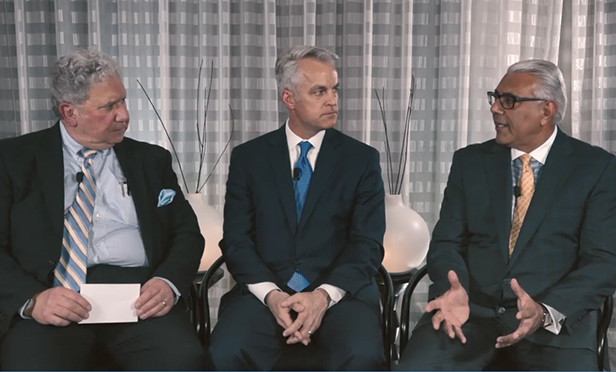 “Physical location still counts,” said Marcus & Millichap president and CEO Hessam Nadji during the firm’s 2018 Retail Trends event, held at Recon.
“Physical location still counts,” said Marcus & Millichap president and CEO Hessam Nadji during the firm’s 2018 Retail Trends event, held at Recon.
LAS VEGAS—Marcus & Millichap CEO Hessam Nadji and recently appointed head of national retail Scott Holmes are realists. As you’ll hear in the exclusive video interview recorded just after the company’s annual Retail Trends press conference, “Retail definitely has issues,” as Nadji stated.
Nevertheless, both executives see opportunity in the market and you’ll also hear Holmes express a certain frustration with the consumer-press headlines that paint a needlessly dire picture of the market to those who matter most: the shopper.
That dual-sided picture was evident throughout the press conference and in Nadji’s opening remarks, wherein he pointed to what he referred to as the peak year of 2017. It was a year that concluded a decade of strong growth.
For instance, despite all of the focus around millennials, baby boomers also offer ripe opportunities for savvy retailers. While it’s true that 12,000 of the younger cohort turned 21 daily last year, Nadji pointed out that 10,000 boomers turned 65 each day. Clearly there are opportunities at both ends of the shopping spectrum.
That peak year also saw a 140-bp decline in the inflation rate, as well as a continued swelling of jobs and households, all positives for the economy and by extension, consumerism.
In fact, he noted, core retail sales were at all-time highs, with a 34% hike since 2007. Nevertheless, he noted a massive “disparity” between pricing and cap rates and another a disparity between core and non-core assets. “Physical location still counts,” the president and CEO stated.
More disparities appear in the much-publicized push/pull between online and brick-and-mortar sales. Physical location still counts here as well, Nadji pointed out. Indeed, online shopping is the fastest-growing segment of retail, and the mobile-commerce piece of that virtual activity is gaining in market share. But brick-and-mortar remains the dominant force in retail. In the presence of these two dynamics, the adaptation of an omni-channel strategy is still the winning direction–for online and physical-store retailers alike.
The various market disparities were highlighted in the panel discussion that followed Nadji’s intro. “There’s a big difference between value-add and distressed assets,” said Daniel Hurwitz of Raider Hill Advisors. “There could be huge opportunities with value-add” that may not exist in distressed assets. “We may not be over-developed. We are under-bulldozed.”
Forward-thinking retailers know how to create opportunity. The Home Depot is one of them, with such innovations as kids’ workshops that not only expose younger folks to the joys of DYI, but simultaneously entice moms and dads into the stores. As the retailer’s Mike LaFerle explained: “The consumer doesn’t differentiate between brick-and-mortar and online. They want what they want at the best price. Adapting to that change is the big challenge.”
And he said that this is what keeps him up at night. The rate at which the market is moving, he said, “is astronomical.”
For Hurwitz, sleepless nights come at the hand of “retail tenants who don’t want to recognize that they’re bad merchants. They’re harming themselves.”
Eric Termansen of Western Retail Advisors suffers from a related dilemma—the inability of retailers to take the long view. “So many operate on a quarter-to-quarter basis,” he told the crowd. “If those executives are not rewarded on a long-term basis, don’t invest there.”
At the market’s current rate of change, both Nadji and Holmes agreed in the video interview that the coming year was going to be an interesting one indeed.

















 Copyright © 2024 ALM Global, LLC. All Rights Reserved.
Copyright © 2024 ALM Global, LLC. All Rights Reserved.